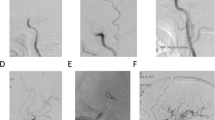Abstract
We report on a 74-year-old man with bilateral internal carotid artery (ICA) disease who suffered a stroke with hemianopia, global aphasia, and right hemiparesis while asleep. Because of the absence of ischemic edema on initial cranial computed tomography (CT) despite a tight stenosis of the proximal left ICA on CT angiogram, we considered angiography and intervention. The digital subtraction angiography (DSA) confirmed a long and tight stenosis of the left proximal ICA containing a thrombus at its distal outflow (Figure 2). Because of further progression of symptoms, we recanalized the left ICA by deployment of a stent and subsequent angioplasty under the protection of abciximab and heparin. The patient improved from an NIH stroke score (NIHSS) of 12 at the time of admission to an NIHSS of 2 within 3 days.
Zusammenfassung
Wir berichten über einen 74-jährigen Patienten, der uns mit einer globalen Aphasie, Hemianopsie nach rechts und ausgeprägter Hemiparese rechts als Notfall zugewiesen wurde (NIH Stroke score [NIHSS] 12). Der genaue Zeitpunkt des Insults konnte nicht festgestellt werden, da der Patient mit den geschilderten Beschwerden um 6.00 Uhr aufwachte. Die kranielle Computertomographie (CT) um 9.15 Uhr zeigte noch kein ischämisches Ödem (Abbildung 1). In der CT-Angiographie ließ sich eine hochgradige Stenose der proximalen Arteria carotis interna (ACI) links darstellen. Die im Anschluss durchgeführte digitale Subtraktionsangiographie (DSA) bestätigte die hochgradige langstreckige Stenose der linken proximalen ACI mit minimalem Restlumen und mit einem Thrombus im distalen Abschnitt der Stenose (Abbildung 2). Der Kontrastmitteleinstrom in die linke Arteria cerebri media (ACM) war deutlich verzögert. Die Stenose wurde mit einem Stent (7 mm × 5 cm) versorgt und dilatiert (Abbildung 3). Begleitend begannen wir eine plättcheninhibitorische Therapie mit Abciximab (0,25 mg/kg als Bolus und anschließender Infusion von 0,125 µg/kg/min für 12 Stunden) und 5000 IU Heparin zur Risikoreduzierung eines sekundären Gefäßverschlusses durch verschleppte Embolien. In der Kontrollangiographie waren die Stenose und der Thrombus nicht mehr nachweisbar. Die Perfusion im Stromgebiet der linken ACI hatte sich normalisiert. Eine diffusionsgewichtete Magnetresonanztomographie (DWI) kurz nach dem Eingriff ergab kleine punktförmige Signalsteigerungen im Endversorgungsgebiet der linken ACM (Abbildung 4). Ein CT am folgenden Tag war regelrecht. Klinisch zeigte der Patient innerhalb von 72 Stunden eine rasche Besserung mit allenfalls leichtgradiger motorischer Aphasie und Schwäche der rechten Hand (NIHSS 2) in der Woche nach der Intervention.
Similar content being viewed by others
Author information
Authors and Affiliations
Corresponding author
Rights and permissions
About this article
Cite this article
Disqué, C., Alex, H., Gahn, G. et al. Stent Protected Angioplasty of the Internal Carotid Artery as an Emergency in Acute Stroke. Klinische Neuroradiolgie 14, 134–137 (2004). https://doi.org/10.1007/s00062-004-5383-5
Received:
Accepted:
Issue Date:
DOI: https://doi.org/10.1007/s00062-004-5383-5




